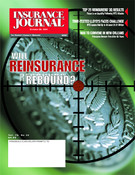How would Sept. 11’s terrorist attacks impact insurers? This was the overwhelming question facing analysts at insurance rating bureaus in the U.S. following the disastrous series of events. In response, analysts downgraded ratings for some insurers, placed others under review and affirmed a select number of others.
With industrywide loss estimates in the range of $30 billion to $70 billion, many analysts have indicated that the events of that Tuesday are unprecedented in both the scope and complexity of potential losses.
Matt Mosher, group vice president-Property & Casualty Ratings at A.M. Best Co., thinks for the most part that while the capital strength of companies has been weakened, most have held up fairly well over the last month.
“[Insurers] had strong capital supporting them prior to this,” Mosher said. “The expectation now is that earnings should improve based on additional rate increases that companies are able to get, although somewhat offset by high reinsurance.”
Mark Puccia, managing director-Financial Services Group at Standard & Poor’s, noted that S& P placed 23 insurers on CreditWatch, identified as being affected by the events of Sept. 11.
“We believe the event is one of capital, not earnings,” Puccia said. “The key thing is to recognize that these companies still do have a lot of financial capital. Our ratings actions anticipate at most, one to two notches change, if at all. For example, someone may go from ‘A+’ to ‘A.'”
Puccia stressed that thus far, S&P and others have only been able to identify $21 to $22 billion worth of insured losses. “That’s what you would get if you went company by company. There are a lot of estimates out there that indicate the losses could be double that.
“We’ve been very comfortable with the rating action we’ve taken so far. We’ve gotten favorable feedback from investors and other industry analysts who think we’ve generally identified the right companies. This is the largest rating action that we’ve ever taken.”
According to Keith Buckley, managing director for Fitch, the most significant downgrade by that company was for Lloyd’s, downgraded from “A+” to “A-.”
“Our sense was, given Lloyds’ mixed business, it probably has as significant an exposure to the events as almost any named company,” Buckley said. “We felt their losses would assuredly be quite large and rate some challenge for the market. There were also a couple—such as Kemper, Atlantic Mutual, Republic Western—those were also influenced heavily by events.”
A.M. Best’s Mosher said one important factor was not releasing ratings too hastily. “We’ve tried to be diligent and not put them out until we feel comfortable with the company or make sure we have all the facts before we take a rating action. We didn’t want to put a blanket ‘under review statement’ out there. We felt we owed it to [insurers] to get some of the information and do some analysis.”
Puccia echoed those sentiments, noting that, “You do need to take your time. You can really segregate the universe of insurers into two groups. There are those companies whose losses you can get a pretty firm grasp on early on, because they’re mostly property coverages and don’t really have the longer tails that need a lot of guesswork. Then there are those who have a lot of casualty exposure and also reinsurance exposure. A lot of these claims haven’t even been presented to them yet. I don’t even think the claimants know they have a claim yet.”
Although Fitch’s Buckley described the ramifications of Sept. 11 as “a beast of $30 billion,” he doesn’t predict irreversible damage for the industry.
“There is no one we see at this time in danger of going into insolvency,” he said. “I think reinsurers will be less willing to provide catastrophic coverage than they have in the past. They will be more choosy in what risks they put their smaller capacity in. I think because of that, some primary insurers reliant on reinsurers will have to choose which policies or companies they’re willing to sell policies to.”
Puccia says that analysts will keep a close eye on claims and events in the coming weeks and months.
“To the extent this becomes a $50-billion event or greater, we think it could have substantially greater ramifications for industry ratings,” Puccia said. “You would see more companies affected and those that we’ve identified could have greater rating action. These claims are not going to come in evenly distributed. What will happen is that there will be specific companies that get much more severely impacted.”
For the coming months, Buckley expects companies that were put on ratings watch to be removed as analysts gain confidence that exposures won’t grow or will be manageable.
The events of Sept. 11 have kept analysts on their toes as they try and get a handle on all the numbers involved. “We’ve had to look at not only the claim exposure companies had, but also look at the investments they hold,” Buckley commented.
“Those numbers [estimates of $30 to $70 billion] are eye-popping,” Puccia said. “They are multiples of the largest catastrophic events we’ve ever seen before. This is a whole new category of claims. This will change the market psyche. Companies are going to re-think how they want to deal with their customers.”
Topics Carriers Reinsurance
Was this article valuable?
Here are more articles you may enjoy.


 Hyundai, Kia Agree to Retrofit 7 Million Vehicles to Address Theft Concerns
Hyundai, Kia Agree to Retrofit 7 Million Vehicles to Address Theft Concerns  Aon Adds to List of Brokers Suing Howden US for Alleged Poaching, Theft
Aon Adds to List of Brokers Suing Howden US for Alleged Poaching, Theft  ‘Door Knocker’ Roofers Were Everywhere. NC Farm Bureau Saw an Opportunity
‘Door Knocker’ Roofers Were Everywhere. NC Farm Bureau Saw an Opportunity  Viewpoint: Artificial Intelligence Is Rewriting the Rules for Commercial Lines
Viewpoint: Artificial Intelligence Is Rewriting the Rules for Commercial Lines 


